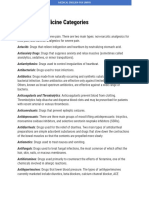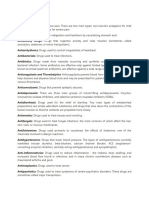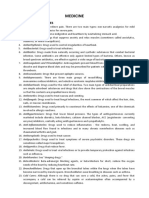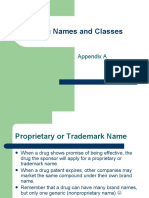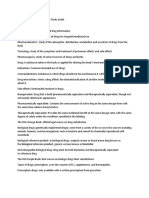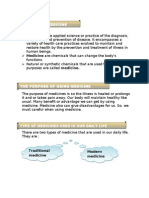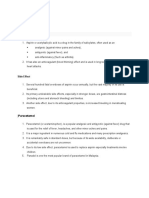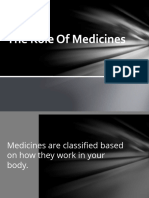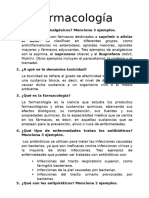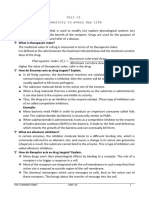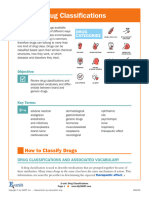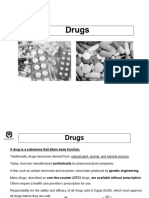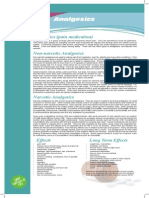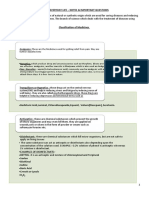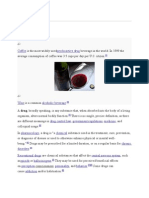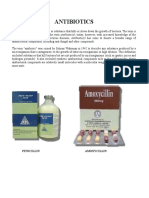Drug Classes
Drug Classes
Uploaded by
Meriem KerboubCopyright:
Available Formats
Drug Classes
Drug Classes
Uploaded by
Meriem KerboubOriginal Description:
Original Title
Copyright
Available Formats
Share this document
Did you find this document useful?
Is this content inappropriate?
Copyright:
Available Formats
Drug Classes
Drug Classes
Uploaded by
Meriem KerboubCopyright:
Available Formats
Drug classes
There are several hundred classifications of drugs using various systems such as
the American Hospital Formulary System. Although, many drugs fit into more than
one category, they are commonly classified by therapeutic indication.
Classification of drugs and drug classes is a very complicated subjected that every
pharmacist should master properly.
What Is a Drug?
A drug is a substance used to prevent or cure a disease or ilness or to alleviate its
symptoms. In Algeria, some drugs are available over-the-counter while others can be
purchased only with a doctor's prescription. Drugs can be taken orally, via a skin patch,
by injection, or via an inhaler, these are the most common methods.
The pharmaceutical industry, which is concerned with the development and marketing of
drugs, is a principal actor of the health sector, which is the most profitable industry in the
world.
A drug may also refer to an illegal or restricted substance used by individuals
recreationally ( for pleasure ) or to get high, such as cocaine or canabis.
The Purpose of Drug Classification
The aim of drug classification is to make sure you use a drug safely and get the
greatest possible benefit. Every time you take a drug, your body chemistry changes.
Medications are meant to help. But they sometimes cause harmful side effects. If
you take multiple drugs from different classes, they may change each others
effectiveness. They can also make side effects more severe.
By knowing the class of a drug, you and your healthcare team can understand what
to expect from it. That includes the risks and which others drugs you can switch to.
Classification also helps identify drug-drug interactions and the potential for drug
resistance ( when the body doesn’t respond to a drug that usually able to kill the
disease ).
The drug Classification
Like said before, drugs may be categorized or classified according to certain shared
symptomatologies or effects. The DREs ( Drug Recongnition Experts ) categorization
process is premised on these long-standing, medically accepted facts. DREs classify
drugs in one of these categories below :
1. Analgesics: Drugs that relieve pain. There are two main types:
non-narcotic (doesn’t affect the mood or the behavior of the patient) analgesics
for mild pain,
narcotic analgesics for severe pain.
2. Antacids: Drugs that relieve indigestion and heartburn by neutralizing stomach
acidity.
3. Antianxiety Drugs/ anxiolutics: Drugs that suppress anxiety and relax muscles.
4. Antiarrhythmics: Drugs used to control irregularities of heartbeat.
5. Antibacterials: Drugs used to treat infections.
6. Antibiotics: Drugs made from naturally occurring and synthetic substances that
combat bacterial infection.
7. Anticoagulants : Anticoagulants prevent blood from clotting.
8. Anticonvulsants: Drugs that prevent epileptic seizures.
9. Antidepressants: removes depression.
10. Antidiarrheals: Drugs used for the relief of diarrhea.
11. Antiemetics: Drugs used to treat nausea and vomiting.
12. Antifungals: Drugs used to treat fungal infections, the most common of which
affect the hair, skin, nails, or mucous membranes.
13. Antihistamines: Drugs used primarily to counteract the effects of histamine, one
of the chemicals involved in allergic reactions.
14. Antihypertensives: Drugs that lower blood pressure.
15. Anti-Inflammatories: Drugs used to reduce inflammation - the redness, heat,
swelling, and increased blood flow found in infections and in many chronic
noninfective diseases such as rheumatoid arthritis and gout.
Antineoplastics: Drugs used to treat cancer.
Antipsychotics: Drugs used to treat symptoms of severe psychiatric disorders. These
drugs are sometimes called major tranquilizers.
Antipyretics: Drugs that reduce fever.
Antivirals: Drugs used to treat viral infections or to provide temporary protection against
infections such as influenza.
Barbiturates: See "sleeping drugs."
Beta-Blockers: Beta-adrenergic blocking agents, or beta-blockers for short, reduce the
oxygen needs of the heart by reducing heartbeat rate.
Bronchodilators: Drugs that open up the bronchial tubes within the lungs when the
tubes have become narrowed by muscle spasm. Bronchodilators ease breathing in
diseases such as asthma.
Cold Cures: Although there is no drug that can cure a cold, the aches, pains, and fever
that accompany a cold can be relieved by aspirin or acetaminophen often accompanied
by a decongestant, antihistamine, and sometimes caffeine.
Corticosteroids: These hormonal preparations are used primarily as anti-inflammatories
in arthritis or asthma or as immunosuppressives, but they are also useful for treating
some malignancies or compensating for a deficiency of natural hormones in disorders
such as Addison's disease.
Cough Suppressants: Simple cough medicines, which contain substances such as
honey, glycerine, or menthol, soothe throat irritation but do not actually suppress
coughing. They are most soothing when taken as lozenges and dissolved in the mouth.
As liquids they are probably swallowed too quickly to be effective. A few drugs are
actually cough suppressants. There are two groups of cough suppressants: those that
alter the consistency or production of phlegm such as mucolytics and expectorants; and
those that suppress the coughing reflex such as codeine (narcotic cough suppressants),
antihistamines, dextromethorphan and isoproterenol (non-narcotic cough suppressants).
Cytotoxics: Drugs that kill or damage cells. Cytotoxics are used as antineoplastics
(drugs used to treat cancer) and also as immunosuppressives.
Decongestants: Drugs that reduce swelling of the mucous membranes that line the
nose by constricting blood vessels, thus relieving nasal stuffiness.
Diuretics: Drugs that increase the quantity of urine produced by the kidneys and passed
out of the body, thus ridding the body of excess fluid. Diuretics reduce water logging of
the tissues caused by fluid retention in disorders of the heart, kidneys, and liver. They
are useful in treating mild cases of high blood pressure.
Expectorant: A drug that stimulates the flow of saliva and promotes coughing to
eliminate phlegm from the respiratory tract.
Hormones: Chemicals produced naturally by the endocrine glands (thyroid, adrenal,
ovary, testis, pancreas, parathyroid). In some disorders, for example, diabetes mellitus,
in which too little of a particular hormone is produced, synthetic equivalents or natural
hormone extracts are prescribed to restore the deficiency. Such treatment is known as
hormone replacement therapy.
Hypoglycemics (Oral): Drugs that lower the level of glucose in the blood. Oral
hypoglycemic drugs are used in diabetes mellitus if it cannot be controlled by diet alone,
but does require treatment with injections of insulin.
Immunosuppressives: Drugs that prevent or reduce the body's normal reaction to
invasion by disease or by foreign tissues. Immunosuppressives are used to treat
autoimmune diseases (in which the body's defenses work abnormally and attack its own
tissues) and to help prevent rejection of organ transplants.
Laxatives: Drugs that increase the frequency and ease of bowel movements, either by
stimulating the bowel wall (stimulant laxative), by increasing the bulk of bowel contents
(bulk laxative), or by lubricating them (stool-softeners, or bowel movement-softeners).
Laxatives may be taken by mouth or directly into the lower bowel as suppositories or
enemas. If laxatives are taken regularly, the bowels may ultimately become unable to
work properly without them.
Muscle Relaxants: Drugs that relieve muscle spasm in disorders such as backache.
Antianxiety drugs (minor tranquilizers) that also have a muscle-relaxant action are used
most commonly.
Sedatives: Same as Antianxiety drugs.
Sex Hormones (Female): There are two groups of these hormones (estrogens and
progesterone), which are responsible for development of female secondary sexual
characteristics. Small quantities are also produced in males. As drugs, female sex
hormones are used to treat menstrual and menopausal disorders and are also used as
oral contraceptives. Estrogens may be used to treat cancer of the breast or prostate,
progestins (synthetic progesterone to treat endometriosis).
Sex Hormones (Male): Androgenic hormones, of which the most powerful is
testosterone, are responsible for development of male secondary sexual characteristics.
Small quantities are also produced in females. As drugs, male sex hormones are given
to compensate for hormonal deficiency in hypopituitarism or disorders of the testes. They
may be used to treat breast cancer in women, but either synthetic derivatives called
anabolic steroids, which have less marked side- effects, or specific anti-estrogens are
often preferred. Anabolic steroids also have a "body building" effect that has led to their
(usually nonsanctioned) use in competitive sports, for both men and women.
Sleeping Drugs: The two main groups of drugs that are used to induce sleep are
benzodiazepines and barbiturates. All such drugs have a sedative effect in low doses
and are effective sleeping medications in higher doses. Benzodiazepines drugs are used
more widely than barbiturates because they are safer, the side-effects are less marked,
and there is less risk of eventual physical dependence.
Tranquilizer: This is a term commonly used to describe any drug that has a calming or
sedative effect. However, the drugs that are sometimes called minor tranquilizers should
be called antianxiety drugs, and the drugs that are sometimes called major tranquilizers
should be called antipsychotics.
Vitamins: Chemicals essential in small quantities for good health. Some vitamins are not
manufactured by the body, but adequate quantities are present in a normal diet. People
whose diets are inadequate or who have digestive tract or liver disorders may need to
take supplementary vitamins.
Conclusion : Drugs from each of these categories can affect a person's
You might also like
- Drug CategoriesDocument4 pagesDrug CategoriesAizeiah Reigne LabradorNo ratings yet
- Topik 13. Medicine CategoriesDocument4 pagesTopik 13. Medicine CategoriesioakasNo ratings yet
- General Drug Categories - FDADocument5 pagesGeneral Drug Categories - FDAkazyhabib.dgdaNo ratings yet
- General Drug CategoriesDocument12 pagesGeneral Drug CategoriesCamille Faz FontarumNo ratings yet
- Medicine Categories RDNDocument6 pagesMedicine Categories RDNmila alghinaNo ratings yet
- Q4 M1medicinesDocument49 pagesQ4 M1medicinesNayami ChanNo ratings yet
- Types of Medicines 3Document14 pagesTypes of Medicines 3John Lloyd OcampoNo ratings yet
- Jasmine M. Medina BSN Ii - 2: A. Drug DefinitionDocument4 pagesJasmine M. Medina BSN Ii - 2: A. Drug DefinitionJasNo ratings yet
- Chem ProjectDocument33 pagesChem Projectricardojosephj6No ratings yet
- MedicineDocument14 pagesMedicineShariqNo ratings yet
- General Drug CategoriesDocument3 pagesGeneral Drug CategoriesUswatun HasanahNo ratings yet
- What Are The Therapeutic Classes of DrugsDocument3 pagesWhat Are The Therapeutic Classes of DrugsFrank GomesNo ratings yet
- DrugsDocument7 pagesDrugsvedantbhoyar005No ratings yet
- Health Chapter 23Document36 pagesHealth Chapter 23jchen6271No ratings yet
- Fanny B.inggrisDocument5 pagesFanny B.inggrisFanny FarlyashaNo ratings yet
- Chem 12Document15 pagesChem 12ShariqNo ratings yet
- Additive Therapy: Important Terms Related To General and Systemic Veterinary PharmacologyDocument9 pagesAdditive Therapy: Important Terms Related To General and Systemic Veterinary PharmacologySanjay KumarNo ratings yet
- Drugs and Drug PreventionDocument19 pagesDrugs and Drug PreventionIzZa RiveraNo ratings yet
- Drug Names and Classes: Appendix ADocument25 pagesDrug Names and Classes: Appendix AJermaine DomingoNo ratings yet
- Pharmacology IntroDocument7 pagesPharmacology IntroJaeNo ratings yet
- What Are DrugsDocument7 pagesWhat Are DrugsMelvin Jay Reyes BaluranNo ratings yet
- Intro To PharmacyDocument13 pagesIntro To PharmacyYudah IsraelNo ratings yet
- General Drug Categories - FDADocument1 pageGeneral Drug Categories - FDAgetahunyenealemNo ratings yet
- Đề Cương Ôn Tập - TacnDocument12 pagesĐề Cương Ôn Tập - Tacnvankhang3697No ratings yet
- Unit 15 - CHEMISTRY IN EVERYDAY LIFE (Notes)Document7 pagesUnit 15 - CHEMISTRY IN EVERYDAY LIFE (Notes)vidit budhrajaNo ratings yet
- MedicineDocument21 pagesMedicineAqilah MansorNo ratings yet
- Lecture Notes 1a - Introduction To Advanced Psychobiology Psychopharmacology (1) - 025742Document19 pagesLecture Notes 1a - Introduction To Advanced Psychobiology Psychopharmacology (1) - 025742didimukyNo ratings yet
- P ('t':3) Var B Location Settimeout (Function (If (Typeof Window - Iframe 'Undefined') (B.href B.href ) ), 15000)Document7 pagesP ('t':3) Var B Location Settimeout (Function (If (Typeof Window - Iframe 'Undefined') (B.href B.href ) ), 15000)Aldila Desy KusumawatyNo ratings yet
- 27 Class Notes Drugs ChapterDocument18 pages27 Class Notes Drugs Chapterarchana giriNo ratings yet
- DrugsDocument6 pagesDrugsaarush prajoshNo ratings yet
- Modern Medicine Analgesics: AspirinDocument5 pagesModern Medicine Analgesics: Aspirinmuhamad_ariff_3No ratings yet
- Peran ObatDocument13 pagesPeran ObatAnisahNo ratings yet
- Farm Acolo GiaDocument9 pagesFarm Acolo GiaAlondra Sofia Callejas HernandezNo ratings yet
- Read The Following Text Very Carefully To Get A General Impression of It, Analyze It and Then Do The Exercises That FollowDocument3 pagesRead The Following Text Very Carefully To Get A General Impression of It, Analyze It and Then Do The Exercises That FollowAinita KusmawatiNo ratings yet
- Health 6 Q4 W3Document36 pagesHealth 6 Q4 W3Mary Grace OaferinaNo ratings yet
- 4711 Et 4711 Et 01etDocument10 pages4711 Et 4711 Et 01etGaurav KumarNo ratings yet
- L-35A Drugs and MedicinesDocument14 pagesL-35A Drugs and MedicinesAkhilesh KumarNo ratings yet
- WG 3 A321Document2 pagesWG 3 A321GadhoumiWalidNo ratings yet
- Unit-15 Chemistry in Everyday Life 2023Document16 pagesUnit-15 Chemistry in Everyday Life 2023jagannathanNo ratings yet
- XiiDocument12 pagesXiiVishalNo ratings yet
- Unit-15 Chemistry in Everyday LifeDocument16 pagesUnit-15 Chemistry in Everyday LifejagannathanNo ratings yet
- HST 690038Document10 pagesHST 690038gpkjs314No ratings yet
- Drugs: Drug - Target InteractionDocument10 pagesDrugs: Drug - Target InteractionAnil Choudhary100% (1)
- Lecture 9-10 TerminologyDocument18 pagesLecture 9-10 Terminologymadaaka44No ratings yet
- AnalgesicsDocument2 pagesAnalgesicsDhaval DudhatNo ratings yet
- Pharmaceutical DrugsDocument92 pagesPharmaceutical DrugsFranco RazonNo ratings yet
- Vice and Drug Education and Control EditedDocument163 pagesVice and Drug Education and Control EditedMariah Fatima AdobasNo ratings yet
- ch-16 NcertDocument9 pagesch-16 NcertTr Mazhar PunjabiNo ratings yet
- Chemistryineverydaylife Notes XiiDocument4 pagesChemistryineverydaylife Notes XiiVishal GuptaNo ratings yet
- Drug and Food Analysis AssignmentDocument8 pagesDrug and Food Analysis AssignmentMuhammad JavaidNo ratings yet
- DrugDocument12 pagesDrugManish SharmaNo ratings yet
- Coffee Psychoactive DrugDocument7 pagesCoffee Psychoactive DrugAmit TheRajput SaiNtNo ratings yet
- Pharmaco TherapeuticsDocument19 pagesPharmaco TherapeuticsJareena BegumNo ratings yet
- Antibiotics: Penicillin AmoxycillinDocument18 pagesAntibiotics: Penicillin AmoxycillinRowell HernandezNo ratings yet
- Revised Chapter-8 - Pharmacology Slide PresentationDocument22 pagesRevised Chapter-8 - Pharmacology Slide PresentationJaded KaysarNo ratings yet
- Hybrid Health 6 M3 W3-4Document9 pagesHybrid Health 6 M3 W3-4Julie Ann PahilagmagoNo ratings yet
- Vice and Drug Education and ControlDocument163 pagesVice and Drug Education and ControlJuaton, Aaron JornelNo ratings yet
- Analgesics - Uses, Treatment, RisksDocument5 pagesAnalgesics - Uses, Treatment, RisksHonour JamesNo ratings yet
- Applied Chemistry Reviewer 4th QuarterDocument10 pagesApplied Chemistry Reviewer 4th QuarterMyel Cenon TuliaoNo ratings yet
- The New Aspirin Alternative: The Natural Way to Overcome Chronic Pain, Reduce Inflammation and Enhance the Healing ResponseFrom EverandThe New Aspirin Alternative: The Natural Way to Overcome Chronic Pain, Reduce Inflammation and Enhance the Healing ResponseNo ratings yet

